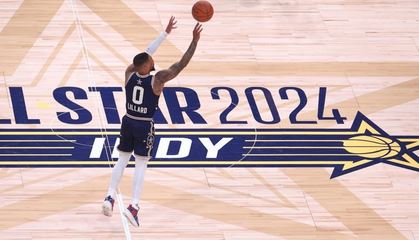Podcast: Play in new window | Download
Subscribe: RSS
The NBA All-Star game was played Sunday evening. The score was 104-89 – at the half!
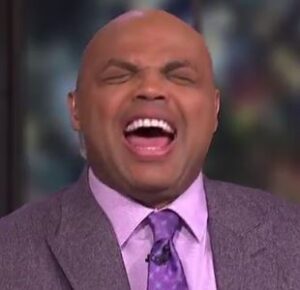
In a (cough) basketball game which embarrassed everyone associated with this game, the East prevailed over the West 211-186.
The final score was just a 3-pointer short of 400 total points scored. The East All-Stars made 83 of 146 shots from the field (57%), while the West converted 80 of 143 (56%) of their shot attempts.
A total of 289 shots were attempted in this 48-minute basketball game. That equates to six shot attempts taken each minute. That’s one every 10 seconds. The Indianapolis crowd should have been handed a tube of SportsCreme on their way out of the arena to rub on their soon-to-be sore necks. The pace of Sunday’s game felt like you were watching a table tennis match.
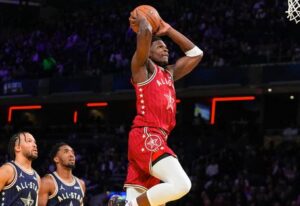
West back-up center Karl-Anthony Towns came off the bench and played 27 minutes in the All-Star game. He connected on 23 of 35 shots for 50 points. Towns averaged nearly 1.5 shots for every minute he played in the game.
Who are you calling a ball hog?

As for defense, there were just three blocked shots in Sunday’s NBA All-Star game. A total of five free throws were attempted for the entire game.
*Special note to the NBA home office – Give the refs a day off next year. They aren’t needed for this game anymore.
Embarrassing? That’s being far too nice
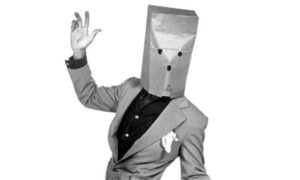
Most of the top NBA writers agree with that sentiment. The NBA All-Star game has turned into a farce.
“That was dreadful. Again. I am beginning to think this game is irredeemable,” said long-time NBA writer David Aldridge.
“Once again, these NBA stars are showing no respect for the game. It’s another Dunkarama and 3-point farce,” tweeted Boston sportswriter Bob Ryan. He added, “What a waste of time. (NBA Commissioner)Adam (Silver), you must do something. It’s embarrassing for your sport.”
The stats confirm the increasing farcical nature of this game in recent years
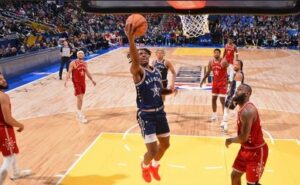
Thirty years ago in 1994 (during the Dream Team seasons), the NBA All-Star game featured a total of 245 points scored by the two teams. Defense was minimal, but the teams still hunkered down a little bit during the final quarter of play as winning the All-Star game mattered a little bit.
By 2014, the NBA All-Stars totaled 318 points in the game. That calculated to an average of 159 points per team. The total number of points was on the high side of credibility. Still, the teams would generate a small amount of defensive effort during the final minutes of the game.
Sunday’s 2024 NBA All-Star game saw 397 points scored. It was, of course, another all-time scoring record.
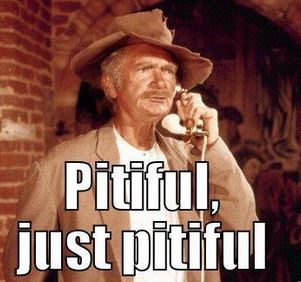
The good people of Indianapolis were fleeced if they came to the arena expecting to watch anything more than a friendly 48-minute intrasquad warm-up session.
The NBA remained the biggest winner at All-Star weekend

This event is a great example of the concept of supply and demand.
Today’s NBA features 30 franchises. That means that the All-Star weekend comes to your city just one time every 28 years (New York and Los Angeles have two teams). It’s hard resist the chance to take your kids see the best men’s basketball players in the world if it finally comes to your market every third decade.
Each year, the host city rolls out the red carpet for this three-day event. Hotels are filled. Restaurants and night clubs are hopping. The host city receives national media focus for much of the entire week.
At Indianapolis last weekend, the NBA hosted events on Friday and Saturday nights in addition to the Sunday evening All-Star game finale. The Friday and Saturday events were played at cavernous Lucas Oil Stadium, the 65,000 seat home of the NFL’s Indianapolis Colts. The Sunday All-Star game was played at the Indiana Pacers’ home arena with 17,250 seats.
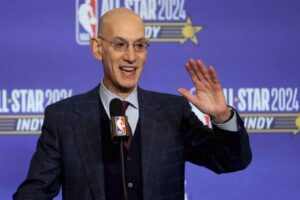
I have no idea of the face value to the tickets to these events. However, I saw a report which indicated that tickets in the nosebleed seats to Sunday’s All-Star game were selling for more than $400 each.
Let’s stipulate that there was no scalping and that the average face-value ticket of an event at the three-day All-Star weekend went an average price of $150 (from upper deck tickets down to the floor seats). That’s probably low. Let’s run the numbers!
If all 147,250 available seats were sold over the three-day weekend for $150 each, the potential ticket revenue for the NBA All-Star weekend at Indianapolis was about $22 million.
How much money did the NBA players take home?
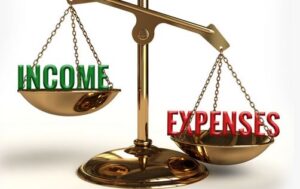
Let’s review the payout going to the players over the three-day NBA All-Star weekend:
Sunday night – Winning All-Star team (East) – $100,000 x 12 = $1,200,000
Sunday night – Losing All-Star team (West) – $25,000 x 12 = $ 300,000
The other events played over the three-day weekend saw players receive a lot of dough, too.
Saturday – Three point contest – $200,000 ($60,000 to the winner)
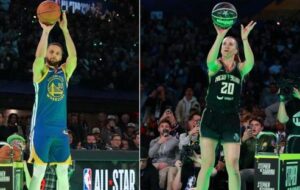
Saturday – Slam dunk contest – $200,000 ($105,000 to the winner)
Saturday – Skills contest – $200,000 ($55,000 to the winner)
Rookies/Sophs/Rising Stars (28 total players) – $490,000 (Winners $25k – Losers $10K)
The total payout to the NBA players this weekend totaled about $2.6 million
In truth, the average NBA player took a pay cut this weekend
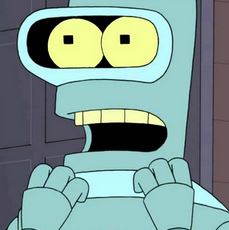
In a recent post, I mentioned that the 2024 average salary for an NBA player was approaching $10 million this season. Based on the NBA’s 82-game regular season that translates to nearly $122,000 per game for an “average” NBA player!
For the basketball players on the winning team of Sunday’s All-Star game, the $100,000 paycheck represented a sizable pay cut when compared to one regular season game.
Let that sink in for a moment.
Why is this game being played anymore?
It’s because the NBA negotiated the All-Star weekend festivities into its most recent television contracts.
The television money is significant. The NBA also earns a ton of money from local ticket buyers during this 3-day basketball circus-like spectacle every year.

Sunday’s All-Star game (played a week after the NFL season ended) garnered a television audience of 5.5 million for Turner Network Television (TNT).
The good news is that the audience represented a double digit increase from the 2023 NBA All-Star game.
The bad news? Last year’s game was the lowest rated NBA All-Star game of all time. Last Sunday’s 2024 game is now the second lowest rated game in NBA All-Star game history.
Several decades ago, the NBA (and most major sports) did not have nightly coverage of its pro basketball games during the regular season. With the advent of cable television, a viewership boom for the NBA happened during the 1980’s and 1990’s. Having Larry Bird, Magic Johnson, and Michael Jordan playing at that time gave the NBA a tremendous TV boost.
The annual All-Star event was once considered a “must see” for fans at home and in the arena to watch the assembly of the best players at the same location.
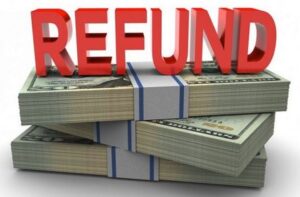
The increasing number of televised NBA games in recent decades has made the All-Star game less “special” to both the current fans and the players, too
What can be done to improve the NBA All-Star game/weekend?
Not very much.

Sunday’s All-Star game is now part of a three-day televised basketball extravaganza every season. The NBA players are the ones who must “force” themselves to show a bit little more effort on the court on behalf of the fans watching the game.
No one wants to see a player get injured. Sunday’s All-Star game statistically proved that the players were generally converting uncontested dunks or tossing-up 3-point shots with virtually no resistance from the opposing team.
The pre-game layup line may have featured a better chance of seeing a hand in a player’s face.
NBA players have become so wealthy that any All-Star weekend earnings (even if directed to their favorite charities) are no longer an incentive. Most would prefer to take the weekend off. That’s exactly what Sunday night’s All-Star game looked like the players were doing, too.
Did I hear someone asking for a few suggestions?
It’s time to end the Saturday night Slam Dunk competition. Unless someone raises the rim to 12 feet (which might be fun), this event has become boring for both the players and fans alike.
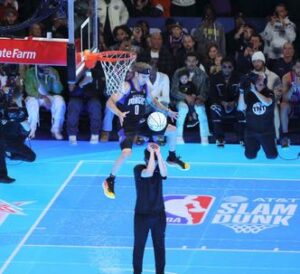
Replace the Saturday night Slam Dunk show with a “H-O-R-S-E” competition (no dunking permitted) featuring some of the players competing in Sunday’s NBA All-Star game. Their competition would come from NBA players from the team of the host city. For example, an Indiana Pacers player would have faced someone like Steph Curry. The fans in attendance would love a chance to root for their local NBA players.
Here’s another freebie. Have the NBA rookies compete against the NBA sophomores for a 20-minute half. After taking a brief break, the winning team returns to play a second half (for additional prize money) against some of their former NBA heroes. This would consist of a group of recently retired NBA stars – under the age of 45-ish. The fans would get a kick out of seeing some of these basketball legends competing in a relatively short game.
Finally, here is an idea which will probably never happen.
Wouldn’t you love to see a local junior high school basketball player (boy or girl) or some old guy in the stands draw the name of a random NBA All-Star player and compete in a 10-shot free throw contest?
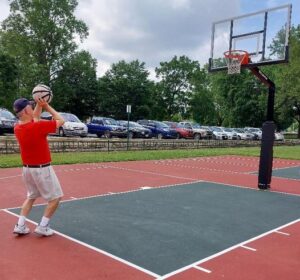
No guts, no glory! However, “no way” will the NBA allow its players to be embarrassed on national television.
That’s too bad! It would be must-see TV.

